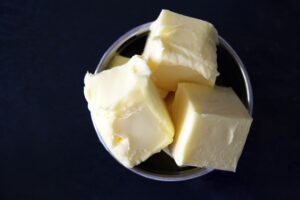Introduction
Ghee, a clarified butter originating from the Indian subcontinent, has been celebrated for its taste, culinary applications, and health benefits. Learn how to make Ghee following the following simple steps.
Benefits of Ghee in Homesteading and Off-Grid Life
In the realm of homesteading and off-grid living, ghee is a true jack-of-all-trades. With a high smoke point, it’s perfect for a variety of cooking techniques, such as sautéing, frying, and roasting. Its excellent shelf-life, requiring no refrigeration, makes it an ideal staple for off-grid living. Moreover, ghee is rich in essential nutrients. The presence of butyric acid and medium-chain fatty acids in ghee aids digestion and boosts immunity, respectively. Ghee can also serve as a dependable energy source, especially vital during strenuous homesteading tasks. Lastly, it’s a sustainable choice, as it can be easily made at home using butter derived from homegrown or locally sourced milk.
Making Ghee: Step-by-Step Guide
- Materials Needed: Unsalted butter, a heavy-bottomed saucepan appropriately sized for the amount of butter you are turning into ghee(you don’t want the ghee to be spread out too thin or it will burn), a sieve, and a heatproof container. I use canning jars and lids. You may also want a splash screen as the butter will bubble.
- Melting the Butter: Place the butter in a saucepan and melt it slowly over low heat. To get the most benefit choose grass feed organic butter if possible.
- Cooking the Butter: Once the butter has melted, keep on the low heat and let it simmer. It will start to bubble and froth. Let it simmer for about 20 minutes, stirring occasionally.
- Removing Impurities: During the simmering process, foam will rise to the surface. Use a slotted spoon or ladle to remove gently.
- Straining the Ghee: After 20 minutes, you will notice that the butter has turned into a clear golden liquid.
- Separation of Milk Solids: Continue to cook the butter until it forms a second layer of bubbles. The milk solids will start to brown and fall to the bottom of the pan.
- Strain the Ghee: Strain the mixture through a sieve into a heatproof container, leaving the browned milk solids in the pan.
You can use the milk solids on toast. Yummy! They should stay good for a couple of days if stored properly.
Bottling and Storing Ghee: Step-by-Step Guide
- Cooling the Ghee: After straining, allow the ghee to cool slightly but not solidify.
- Bottling the Ghee: Pour the slightly cooled ghee into a clean, dry glass jar. Seal the jar tight with a lid to prevent moisture from getting in.
- Storing the Ghee: Store the jar of ghee in a cool, dark place. It doesn’t require refrigeration.
Shelf Life of Ghee
Ghee has an impressive shelf life, especially if stored properly. Typically, a well-sealed jar of ghee can last up to a year in your pantry. However, ensure to use a clean, dry spoon every time you take ghee from the jar to prevent moisture contamination, which can shorten its shelf life.
Using Ghee in Cooking
Ghee is an incredibly versatile ingredient that can be used in a multitude of dishes. It is a beloved ingredient in Indian cuisine, but its rich, nutty flavor can enhance just about any meal in any culinary tradition. Here are some ways to incorporate ghee into your cooking:
- Sautéing and Frying: Ghee offers an exceptional option for sautéing, stir-frying, or deep-frying due to its high smoke point. Its versatility and ability to withstand high heat make it a desirable choice for various culinary applications. You can use it to sauté vegetables or meats, or even use it as a replacement for vegetable oil in your frying pan.
- Baking: Ghee can be used as a healthier alternative to butter in baked goods. It can impart a unique flavor to cakes, cookies, pies, and breads.
- Spreading: Like butter, ghee can be spread on toast or used as a topping on popcorn, offering a delicious, nutty twist to these classic snacks.
- Seasoning: Ghee can be used to season rice, soups, lentils, and a plethora of other dishes, giving them an added depth of flavor.
Remember, because ghee is concentrated, a little goes a long way. Start with a small amount and adjust according to your preference.
Difference Between Ghee and Clarified Butter
Although ghee and clarified butter are both derived from regular butter, they are not exactly the same. Clarified butter, also known as drawn butter, is produced by heating unsalted butter until the water evaporates and the milk solids separate from the butterfat. This leaves behind a golden, clear liquid which is the clarified butter. It carries a mild, creamy flavor and has a relatively high smoke point, making it suitable for cooking.
On the other hand, ghee is essentially clarified butter that has been cooked a little longer to achieve a nuttier flavor. After the milk solids separate from the butterfat, they are left to brown slightly before being strained out. This browning process gives ghee its distinct, rich flavor, deeper golden color, and unique aroma. Moreover, ghee has a slightly higher smoke point than clarified butter, making it a more versatile choice for high-heat cooking. Another distinction lies in their shelf lives, with ghee typically lasting longer than clarified butter, even when not refrigerated.
Health Benefits of Ghee
Ghee is much more than a flavorful addition to your dishes; it’s also packed with myriad health benefits.
- Rich in Vitamins: Ghee is a good source of fat-soluble vitamins A, D, E, and K. These vitamins are essential for a wide range of body functions, from maintaining healthy vision to ensuring proper bone health.
- Supports Digestion: The butyrate present in ghee helps support a healthy digestive tract. It serves as a source of energy for the cells in your colon and can promote the growth of beneficial gut bacteria.
- Promotes Heart Health: Contrary to popular belief, the fats in ghee can actually be good for your heart when consumed in moderation. The conjugated linoleic acid in ghee has been linked to a reduction in heart disease risk factors.
- Anti-Inflammatory Properties: Ghee has been known for its anti-inflammatory properties. Some research suggests that the butyrate in ghee can help decrease inflammation in the body.
- Lactose-Friendly: As ghee is made by removing the milk solids from butter, it is a suitable option for individuals who are lactose intolerant or sensitive to dairy.
Bear in mind, that while ghee has numerous health benefits, it’s also high in calories and should be used in moderation as part of a balanced diet.
Conclusion:
Ghee and clarified butter may seem similar, but they have distinct differences in terms of flavor profile, cooking versatility, and shelf life. Ghee has been known for its health benefits such as supporting digestion, promoting heart health, and having anti-inflammatory properties. However, it is important to consume ghee in moderation as part of a balanced diet.
References:


